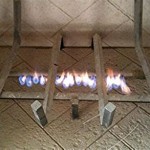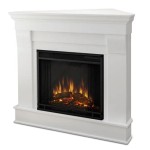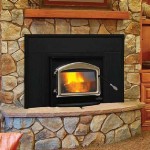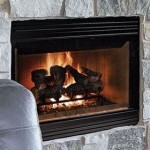Colors To Paint A Fireplace: Transforming Your Hearth
The fireplace, historically a focal point for warmth and gathering, continues to hold a prominent place in many homes. Beyond its functional purpose, it represents a visual anchor, influencing the overall aesthetic and ambiance of a living space. While initial construction materials like brick, stone, or tile possess inherent characteristics, painting the fireplace provides an opportunity to customize its appearance, aligning it with personal style and enhancing the room's design scheme. The selection of appropriate colors is vital in achieving the desired transformative effect.
Before embarking on the painting process, a thorough assessment of the fireplace and surrounding area is essential. The existing material of the fireplace (e.g., brick, stone, concrete, wood mantel), the architectural style of the home, and the existing color palette of the room all influence the optimal color choice. Careful consideration should also be given to the fireplace's purpose: is it primarily decorative, or is it actively used for burning wood? The latter consideration significantly impacts the type of paint required, necessitating heat-resistant options.
The impact of color on visual perception should be understood. Lighter colors generally create a sense of spaciousness and brightness, reflecting light and making a room feel larger. Conversely, darker colors tend to absorb light, creating a cozier and more intimate atmosphere. The size of the room and the amount of natural light it receives should inform the color selection. A small, dimly lit room might benefit from a lighter color on the fireplace to brighten the space, while a large, sun-drenched room could accommodate a darker, more dramatic color.
Evaluating Existing Conditions and Material Types
The existing condition of the fireplace is a significant factor in determining the preparation required before painting. Cleaning is a paramount first step. Years of soot, dust, and grime can accumulate, particularly on brick fireplaces that have been actively used. A solution of trisodium phosphate (TSP) and water is typically effective for cleaning brick and stone, although appropriate safety precautions, including the use of gloves and eye protection, should be observed. Rinsing thoroughly with clean water and allowing the fireplace to dry completely are crucial steps before proceeding with any painting.
Different materials require different preparatory steps. Brick, being porous, may require priming to ensure proper adhesion and prevent the paint from being absorbed unevenly. A masonry primer specifically designed for brick surfaces is recommended. Stone fireplaces, depending on the type of stone, may also benefit from priming, although some types of stone may not require it. Wood mantels, if present, should be sanded to create a smooth surface and primed with a wood primer. The presence of any existing paint or sealant should be addressed before priming to ensure proper adhesion of the new paint layer.
Consider the type of mortar used in the fireplace construction. Older mortars may be more fragile and require careful cleaning and preparation. Any cracks or crumbling mortar should be repaired before painting to prevent moisture from penetrating the brick or stone and causing further damage. A suitable mortar repair compound should be used, following the manufacturer's instructions carefully.
Exploring Color Palettes and Aesthetic Goals
The color palette chosen for the fireplace should complement the overall design scheme of the room. Consider the colors of the walls, furniture, and flooring. A cohesive color scheme creates a harmonious and visually appealing space. There are several approaches to selecting a color palette. A monochromatic palette uses different shades of the same color, creating a subtle and sophisticated look. A complementary color palette uses colors that are opposite each other on the color wheel, such as blue and orange, creating a vibrant and contrasting effect. An analogous color palette uses colors that are next to each other on the color wheel, such as blue, blue-green, and green, creating a harmonious and calming effect.
The desired aesthetic should also guide the color choice. A traditional aesthetic might call for neutral colors, such as off-white, beige, or gray. These colors create a classic and timeless look. A modern aesthetic might incorporate bolder colors, such as black, charcoal gray, or even a vibrant accent color. These colors can create a dramatic and eye-catching focal point. A rustic aesthetic might emphasize natural colors, such as earthy browns, muted greens, or warm grays. These colors evoke a sense of warmth and nature.
Visualizing the final result is crucial. Paint swatches should be tested on a small, inconspicuous area of the fireplace before committing to the entire project. Observe the color under different lighting conditions, both natural and artificial, to ensure that it meets expectations. Online tools and design software can also be helpful in visualizing different color combinations and assessing their impact on the overall room design.
Paint Selection and Application Techniques
The type of paint used on a fireplace is critical, particularly if the fireplace is used for burning wood. Regular latex paint is not suitable for areas exposed to high heat. High-heat paint, specifically designed for fireplaces and stoves, is essential for preventing paint from blistering, peeling, or emitting harmful fumes. These paints are typically available in aerosol cans or liquid form and are formulated to withstand temperatures up to several hundred degrees Fahrenheit.
For fireplaces that are primarily decorative or have a non-combustible surround, a wider range of paint options is available. Latex paint is a common choice due to its durability, ease of application, and wide availability of colors. Acrylic paint is another option, offering similar benefits with enhanced resistance to fading and chipping. Chalk paint can be used to create a matte, distressed finish, adding character and texture to the fireplace. Consider the desired sheen level when selecting paint. Matte paint offers a flat, non-reflective finish, while satin paint has a subtle sheen. Semi-gloss and gloss paints are more reflective and durable but may highlight imperfections in the surface.
Proper application techniques are essential for achieving a professional-looking finish. Use a brush, roller, or paint sprayer to apply the paint evenly, following the manufacturer's instructions. Multiple thin coats are generally preferable to a single thick coat, as they provide better coverage and prevent drips and runs. Allow each coat to dry completely before applying the next. Pay particular attention to details, such as corners, edges, and mortar joints, ensuring that they are adequately covered. Masking off the surrounding area with painter's tape will protect walls and flooring from paint splatters. Adequate ventilation is essential during the painting process, and appropriate safety precautions, such as wearing a respirator, should be observed.

The Top Color Ideas For Painting A Brick Fireplace 700 N Cottage

Our Black Painted Fireplace Bright Green Door

7 Beautiful Ideas For Painting Interior Brick Fireplaces

Pin On Home Sweet

ᑕ❶ᑐ How To Paint Your Brick Fireplace For Home

Paint Color Picks For Magnificent Mantels Tinted Sherwin Williams

Our Black Painted Fireplace Bright Green Door
:max_bytes(150000):strip_icc()/195949384_533489974504579_3035995865627682669_n-3c30dc0791c74ced9847f823ec3a55d1.jpg?strip=all)
30 Gorgeous Painted Fireplace Ideas

30 Gorgeous Painted Brick Fireplace Ideas

Before After Brick Anew Fireplace Paint
Related Posts








